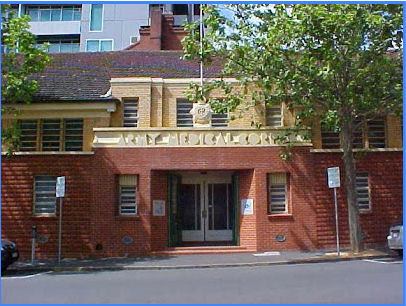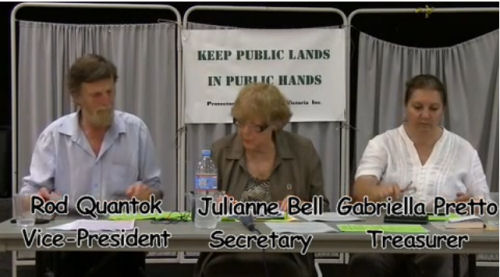
 "Labor is developing what is meant to be the most fundamental restructure of the Victorian planning system since the 1996 introduction of the Victoria Planning Provisions, the new Smart Planning program. [...] A simpler, more efficient and certain planning scheme is long overdue, but Smart Planning is not the way to provide it. This is a $25 million program managed through the Smart Planning program Rules team. If the system is simply to implement five minor changes, along with online access, then the program is a massive waste of money. Alternatively, if future stages are to radically change the system, then the government is hiding its intentions, locking out community groups from the process, and intends to present the public with a fait accompli." (Professor Michael Buxton*)
"Labor is developing what is meant to be the most fundamental restructure of the Victorian planning system since the 1996 introduction of the Victoria Planning Provisions, the new Smart Planning program. [...] A simpler, more efficient and certain planning scheme is long overdue, but Smart Planning is not the way to provide it. This is a $25 million program managed through the Smart Planning program Rules team. If the system is simply to implement five minor changes, along with online access, then the program is a massive waste of money. Alternatively, if future stages are to radically change the system, then the government is hiding its intentions, locking out community groups from the process, and intends to present the public with a fait accompli." (Professor Michael Buxton*)
Labor is developing what is meant to be the most fundamental restructure of the Victorian planning system since the 1996 introduction of the Victoria Planning Provisions, the new Smart Planning program.
For the first time, the government has issued a tender for significant private sector involvement in the development of this program. A private consulting company has been given the significant role in developing what is meant to be further privatisation of the planning system.
Nobody knows what the precise instructions to this firm are because few public criteria were provided. However enough is known to provide a broad outline of government intentions. Criteria include the need to reduce regulation and regulatory costs by simplifying planning rules particularly through code assessment, lowering the level of permit triggers, increasing ‘as-of-right’ approvals and reducing local variation. The result will be a new model planning scheme which includes a new structure for the Victoria Planning Provisions (VPP) and new content including revised zones, overlays and particular provisions.
The new system is being promoted on the need to ‘simplify and modernise Victoria’s planning rules’, reduce complexity and increase efficiency. The rhetoric of ‘cutting red tape’ and ‘reform’ are used to sell an increasingly deregulated system.
Stages in the process
There are two main elements to the process:
• The Rules and Policy stream which is making changes to the regulatory content and structure of the VPP;
• The Systems Stream which will make substantial changes to online planning information including a single point of entry to information, an online lodgement system for permits and planning scheme amendments, the content of planning schemes, and interactive state-wide maps. At this stage, this component will not include a single online centralised portal for all planning applications.
Under the Rules and Policy stream, the government envisages four stages in the process.
Stage 1 was the addition of further categories to VicSmart focusing on residential zones
Stage 2 will comprise a first package of further changes to VicSmart, and allegedly minor changes to the VPPs..
Stage 3 is intended to include a major restructure of the VPP and implemented in mid-2018.
Stage 4 will ‘further reshape the planning system’ in even more fundamental ways. under a program titled Transform.
Consultation
The property industry is an enthusiastic advocate for Smart Planning. The Property Council, for example, stated that the new system “is exactly what the doctor ordered…to cut red tape…and accelerate decision making”.
However, community groups have been locked out of the entire Smart Planning process.
Property and professional groups are represented on the technical reference and advisory groups for the program but not residents. The following groups are represented on the advisory group:
• Municipal Association of Victoria
• Australian Institute of Architects
• Building Designers Association of Victoria
• Housing Industry Association
• Master Builders Association of Victoria
• Planning Institute of Australia
• Property Council of Australia
• Urban Development Institute of Australia
• Victorian Planning and Environmental Law Association.
No members of relevant community groups of the public are represented on either the technical or the advisory group.
A Smart Planning presentation to industry organised by the Planning Institute on 31 October, proposed the following reasons for the exclusion of the public from consultation:
• Members of the public are incapable of understanding strategic planning
• Members of the public might initially object to changes to planning systems or specific developments but invariably ultimately accept them
• The large number of past reports into planning make further public consultation unnecessary.
A survey was released into potential VPP changes with a completion date of 10 July. Professionals made up most of the 688 respondents.
A discussion paper into broad proposals for Stage 1 changes was released on 16 October along with an online questionnaire with responses required by 24 November.
Stage 1 changes to VicSmart were introduced without the opportunity for public consultation in mid 2017.
Stage 2 changes will be presented to the minister and, if necessary, cabinet for approval in December for immediate adoption. This means that changes to the planning system will be immediately implemented without making the content of changes publicly available prior to adoption. The public will be presented with a fait accompli.
Stage 3 and 4 changes are expected to proceed in the same way as stage 2.
VicSmart changes
The government introduced a dual track approval system into Victorian planning with the enactment of the Planning and Environment Amendment (VicSmart Planning Assessment) Act in September 2012. Clauses 90–95 inserted into the VPP implement the VicSmart system. The Act establishes a different approval procedure for a separate class of applications but does not define this class or specify these applications. These are listed in clause 92 and initially comprised relatively minor and uncontroversial applications for various zones including subdivision to align a common boundary; construction of a fence, carport or garage; and construction of buildings and works of less than $50,000 in value not within 30 metres of a residential zone.
Clause 91 sets out the process for VicSmart applications. Applications must be processed within 10 business days and are exempt from notice, decision guidelines and review rights, policies or other provisions, although applicants may appeal a decision by the responsible authority; the responsible authority cannot request further information; authorities cannot act as referral authorities for comment on an application; environmental impacts cannot be considered; and councillors are excluded from decisions.
The government justified the introduction of a separate track by the need for a streamlined permit process aimed at ‘straightforward, low impact development proposals’, intended to ‘reduce frustration and unnecessary red tape for families wanting to make simple improvements to their homes’ and reduce ‘unnecessary delays and costs in Victoria's planning system’. However, the failure of the legislation to list the class of applications and conferring on the minister the power to develop and alter the list without further reference to parliament has allowed the progressive extension of the system by expanding the classes of applications. The then Shadow Minister for Planning, Brian Tee, commented in the parliamentary debate on the VicSmart Bill that ‘we all know that this legislation is much broader in its scope; the sky is the limit’.
The 2017 changes to VicSmart were introduced through Amendment VC137. This allowed extensions to dwellings in residential zones without a permit, and doubled the class of applications for buildings and works in a range of zones to $100,000.
These VicSmart changes have helped double VicSmart applications to 8 per cent. Further Stage 1 changes are expected to increase them to 14 per cent, ultimately rising possibly to one third of all applications. The 2016 budget estimates states that the Smart Planning program “will enable an extension to the VicSmart process, including the targeted removal of permit requirements in commercial and industrial zones, allowing faster approval times for certain development proposals….[its] proportion of planning permit applications will increase over time as reforms aimed at streamlining the planning system take hold”. It is likely that this process will reduce or remove existing rights to notice and appeal against classes of medium and high rise developments.
Stage 2 changes
Vicsmart will be integrated into particularly provisions and overlay schedules and other provisions. At present, VicSmart operates as a separate section at the end of planning schemes. Its integration into other provisions will entrench it structurally, providing codified assessments, uses and developments exempt from permits and applications exempt from notice or review. This integration will make further increases to VicSmart applications inevitable. A list of five new classes of applications is proposed at present.
Local and State planning policy will be integrated. Since local policy cannot contradict State policy, this will probably weaken local policy.
Streamlined assessment pathways will be provided by amending specific provisions to add building and works exemptions, reduce permitted applications by increasing ‘as-of-right’ uses and developments, and reduce the number of prohibited uses.
Drafting and procedural changes will be made.
Stage 3 and 4 changes
The discussion paper does not outline these. However, it is clear from the October 2017 discussion paper, Reforming the Victoria Planning Provisions, and other Smart Planning material, that radical changes to the planning system are envisaged under stages 3 and 4.
A revealing indicator of the government’s approach is the reference to the Leading Practice Model for Development Assessment prepared by the Development Assessment Forum in 2005. This influential model prepared by a body composed primarily of development and professional groups has been progressively implemented by all State governments to deregulate planning systems. The paper also refers to the use of code assessment and exemptions in New South Wales and Queensland systems. These are the most deregulated in Australia. Yet the government’s overall aim for Smart Planning is to “make Victoria’s planning system the most efficient and responsive in Australia”.
The government provides little detail of how radically the Stage 3 and 4 changes will further deregulate the planning system. However, the documentation provides a sense of what is envisaged. A progressive process of change is envisaged through “successive VPP and planning scheme amendments”. The program “seeks to deliver long term, transformative changes to the planning system”. The discussion paper proposes code assessment for multiple dwellings in defined locations, increasing code assessment to remove “entirely from the need for assessment” more applications, and applying VicSmart to complex applications. The Transform process would “further reshape the planning system” for the next 30 years.
Some proposed more detailed amendments to provisions include:
• Exempt single dwellings on lots above 300 square metres.
• Increase exempt uses in commercial and mixed use zones
• Make office an exempt use in the Industrial 3 zone.
• Increase exempt commercial uses in the Farming zone.
• Review the need for permits under all overlays and liberalise Floodway and Land Subject to Inundation overlays.
• Exempt car parking requirements in nominated zones
• Exempt premises in commercial zones from planning permits for licenced and gambling premises
• Further deregulate the Heritage Overlay by removing the need for permits for dry stone walls.
• Remove clause 57 providing greater control over uses and developments in green wedge land.
• Remove the powers of referral authorities
• Review the role of Section 173 agreements and decision guidelines.
Omissions
A simpler, more efficient and certain planning scheme is long overdue, but Smart Planning is not the way to provide it. This is a $25 million program managed through the Smart Planning program Rules team. If the system is simply to implement five minor changes, along with online access, then the program is a massive waste of money. Alternatively, if future stages are to radically change the system, then the government is hiding its intentions, locking out community groups from the process, and intends to present the public with a fait accompli.
The Smart Planning process addresses none of the major problems associated with the VPPs. These problems all arise from the lack of effective regulation, not the need for further deregulation. In particular
• The recent deregulation of the residential zones should be reversed
• Height controls should be added to the commercial and mixed use zones to protect historic strip and local retail centres
• The extensive out-of-centre development allowed in commercial zones, which allows further unfair competition with traditional centres and entrenches car based centres, should be controlled.
• The few prohibited uses in commercial and mixed use zones should be expanded
• Greater heritage protection should be provided to historic industrial areas to require building reuse not demolition.
• The former rural zones should be reinstated
• Commercial uses should be prohibited in Green Wedge zones and all uses not listed in section 2 prohibited.
• Vague and contradictory decision guidelines and objectives should be rewritten in a clear, regulatory manner.
• The widespread inadequate application of standard provisions to land by local councils should be addressed to better match provisions to local conditions and need.
* About Michael Buxton
Michael Buxton is Professor of Environment and Planning at RMIT University and former head of the RMIT planning program. He spent 12 years in senior management in planning and environmental agencies in the Victorian Government and has written widely on urban form, peri-urban development and environmental policy.

 Venue: Camberwell Historical Society Meeting 25 February 2025 7.30pm. Speaker Michael Buxton, "Camberwell: Urban Planning and Heritage Protection." 25 Inglesby Road, Camberwell 3124. RSVP by Monday 24 February 2025. [email protected] or George Fernando 0448296258. Camberwell is one of the State Government’s proposed Activity Centres. The suburb of Camberwell developed in the 1880s.
Venue: Camberwell Historical Society Meeting 25 February 2025 7.30pm. Speaker Michael Buxton, "Camberwell: Urban Planning and Heritage Protection." 25 Inglesby Road, Camberwell 3124. RSVP by Monday 24 February 2025. [email protected] or George Fernando 0448296258. Camberwell is one of the State Government’s proposed Activity Centres. The suburb of Camberwell developed in the 1880s.
 "The Victorian government is preparing Plan for Victoria – a strategic framework for the whole state – while it simultaneously rolls out the most radical program of planning system reforms in thirty years. This report summarises the publicly available information on both, adds analysis and commentary, and offers constructive feedback in the form of positive propositions.
"The Victorian government is preparing Plan for Victoria – a strategic framework for the whole state – while it simultaneously rolls out the most radical program of planning system reforms in thirty years. This report summarises the publicly available information on both, adds analysis and commentary, and offers constructive feedback in the form of positive propositions. Planning Democracy, and the Green Wedges Coalition Inc., are pleased to invite you to the launch of the Liveable Victoria Manifesto.
Planning Democracy, and the Green Wedges Coalition Inc., are pleased to invite you to the launch of the Liveable Victoria Manifesto. The National Trust of Australia (Victoria) and the Royal Historical Society of Victoria invite you to attend the launch of the National Trust’s Advocacy Toolkit. This free online resource, supported by the Victoria Law Foundation, will [try to] provide communities across Victoria with the tools they need to protect their natural and cultural heritage. Wednesday 16 May, 12.45pm at Royal Historical Society of Victoria, 239 A'Becket Street, Melbourne.
The National Trust of Australia (Victoria) and the Royal Historical Society of Victoria invite you to attend the launch of the National Trust’s Advocacy Toolkit. This free online resource, supported by the Victoria Law Foundation, will [try to] provide communities across Victoria with the tools they need to protect their natural and cultural heritage. Wednesday 16 May, 12.45pm at Royal Historical Society of Victoria, 239 A'Becket Street, Melbourne.

 "Labor is developing what is meant to be the most fundamental restructure of the Victorian planning system since the 1996 introduction of the Victoria Planning Provisions, the new Smart Planning program. [...] A simpler, more efficient and certain planning scheme is long overdue, but Smart Planning is not the way to provide it. This is a $25 million program managed through the Smart Planning program Rules team. If the system is simply to implement five minor changes, along with online access, then the program is a massive waste of money. Alternatively, if future stages are to radically change the system, then the government is hiding its intentions, locking out community groups from the process, and intends to present the public with a fait accompli." (Professor Michael Buxton*)
"Labor is developing what is meant to be the most fundamental restructure of the Victorian planning system since the 1996 introduction of the Victoria Planning Provisions, the new Smart Planning program. [...] A simpler, more efficient and certain planning scheme is long overdue, but Smart Planning is not the way to provide it. This is a $25 million program managed through the Smart Planning program Rules team. If the system is simply to implement five minor changes, along with online access, then the program is a massive waste of money. Alternatively, if future stages are to radically change the system, then the government is hiding its intentions, locking out community groups from the process, and intends to present the public with a fait accompli." (Professor Michael Buxton*) Responding to "Plan Melbourne 2017-2050" and changes to the Planning Scheme which will transfer government powers to private developers, Planning Backlash will rally on the steps of Parliament on 8 June 2017 at 1pm.
Responding to "Plan Melbourne 2017-2050" and changes to the Planning Scheme which will transfer government powers to private developers, Planning Backlash will rally on the steps of Parliament on 8 June 2017 at 1pm. Saturday 4 July 2015, First Annual General Meeting: Guest Speaker is Professor Michael Buxton of the School of Global, Urban and Social Studies at RMIT University is a leading urban planning expert and will speak on “Melbourne Towards Eight Million: Are Skyscrapers the answer?”
Saturday 4 July 2015, First Annual General Meeting: Guest Speaker is Professor Michael Buxton of the School of Global, Urban and Social Studies at RMIT University is a leading urban planning expert and will speak on “Melbourne Towards Eight Million: Are Skyscrapers the answer?”
 "Both the process and the discussion paper are undirected, unsatisfactory and of little help to anyone or anything. Nothing so inadequate has ever been seen in the history of Melbourne strategic planning."... "The paper generally avoids any discussion of how to intensify established areas while not destroying amenity, or even whether it is possible to achieve both objectives. It does not discuss in detail the major options for intensification, mentioning only briefly the capacity to redevelop large brownfield sites, and arguing that medium and higher density residential development should not be regarded as a problem. It states that “there are different ways of increasing housing density without undermining the valued characteristics of local areas” – what are these and why would they not destroy valued amenity?"(Michael Buxton, Professor Environment and Planning, at PPLVic AGM on Saturday 23 February 2013.
"Both the process and the discussion paper are undirected, unsatisfactory and of little help to anyone or anything. Nothing so inadequate has ever been seen in the history of Melbourne strategic planning."... "The paper generally avoids any discussion of how to intensify established areas while not destroying amenity, or even whether it is possible to achieve both objectives. It does not discuss in detail the major options for intensification, mentioning only briefly the capacity to redevelop large brownfield sites, and arguing that medium and higher density residential development should not be regarded as a problem. It states that “there are different ways of increasing housing density without undermining the valued characteristics of local areas” – what are these and why would they not destroy valued amenity?"(Michael Buxton, Professor Environment and Planning, at PPLVic AGM on Saturday 23 February 2013. 

 "I am just amazed at the breadth and the depth of interest and knowledge about planning in groups like this, so I don't understand - given that - how the government gets away with what it does."(Prof. Michael Buxton)
"I am just amazed at the breadth and the depth of interest and knowledge about planning in groups like this, so I don't understand - given that - how the government gets away with what it does."(Prof. Michael Buxton)
Recent comments